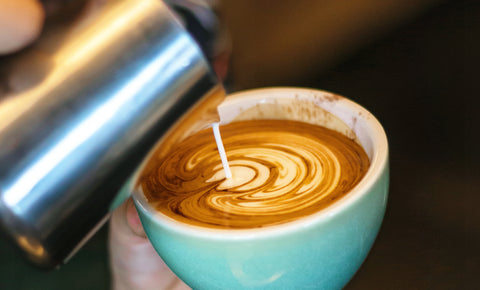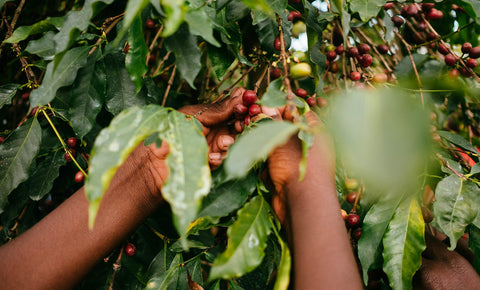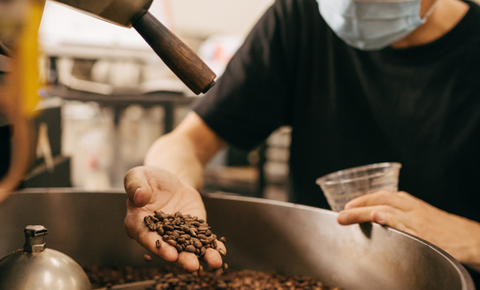We're committed to proving that you don't have to sacrifice quality, the environment or your ethics for the sake of caffeinated convenience, and I believe our latest barrier-busting coffee product, our Instant Specialty Coffee, made from our own CMCR Espresso Blend, proves just that.
I sat down with the man behind Instant Specialty, Marcus Allison, to understand more about the science and wizardry that goes into turning one of our most beloved blends into something that is ready to drink in seconds, and generally geek out about coffee.
Matt - How did you get into the Instant Specialty game? What was the impetus to start?
Marcus - I've been in the coffee industry since 2010 and always thought a bit outside the box. We were one of the first companies in Brisbane to bottle iced coffees in glass stubbies through our cafe, [Bunker]. Instant Specialty started when I saw some companies in the US were experimenting with making high-quality, instant coffee and it made me wonder why Instant Coffee normally tasted so bad.
I started to research how the big commercial businesses do it and pretty quickly began to understand how it could be improved, when quality is the focuss, rather than quantity and price. I was actually drinking my own Instant Specialty coffee as long ago as late 2017 and I played with it for about 12 months before we launched it as a business.
Our product is unique compared to any other I have tasted so far.
Matt - Take us through the steps our coffee goes through, from the whole bean, roasted product, to get to the finished Instant Specialty.
Marcus - The short story is, we extract the coffee into a liquid and freeze dry it. But here's the long story...
All coffee beverages start as roasted coffee beans. The beans are usually ground to make the particle size smaller and the internal structure of the bean more accessible. Typically you then use hot water to dissolve the parts of the coffee bean that are soluble (able to be dissolved). Once you have dissolved/extracted as much as you want, you then separate the liquid from the parts of the bean that are not soluble (can't be dissolved by the water) and....hello coffee!
That's a very nerdy way to describe how to make a coffee, but that's how I think about it. There are a myriad of different ways to do what I just described including, french press, pour-over, espresso machine, batch brewers, aeropress etc and each one produces a unique style of coffee at a particular strength. While we can't disclose the exact method we have developed to extract the coffee into a liquid, I am happy to share that we use hot water only. Our method is scalable and produces a very consistent and delicious result.
Commercial instant coffee manufacturers typically use equipment and processes that are capable of dissolving 50-60% of the weight of the roasted bean. In the coffee biz we call the "extraction percentage". Before embarking on this endeavour I believed, as is commonly told, that only 30% of the roasted coffee bean was actually soluble, so it came as a huge surprise to me that the commercial process could nearly double this level of extraction!
Most specialty coffee shops actually only extract 20-22% of the weight of the bean when making a beverage, as this is what tastes the best. Beyond that 20-22% and the drink starts getting bitter and nasty. Because we are targeting quality, rather than quantity, similar to your favourite specialty coffee like Common Man, we generally extract only 20-22% of the weight of the bean. The liquid coffee we produce is then freeze dried to remove the water, leaving you only with the coffee that was dissolved in it.
This is actually an amazing process but I'll describe it very briefly - The liquid coffee is frozen and placed inside the freeze dryer. The dryer, shaped like a giant capsule, is then sealed and a vacuum reduces the pressure inside the dryer to almost nothing; it is very close to being in outer space. This allows for a process called "sublimation" to occur when the frozen coffee is gently heated. Instead of the frozen coffee melting and turning back into a liquid, sublimation occurs and the water content of the frozen coffee skips the liquid phase and turns straight into a gas. This gas is collected and removed from the dryer and what is left behind is our Instant Specialty coffee. This is then removed from the dryer, powdered and packaged up for you lucky consumers.
All you need to do is add hot water back to it and it will turn back into a liquid that is ready to drink!
Matt - You’ve recently started using new and improved equipment in the process - how has the equipment improved and what effect does this have on the finished result?
Marcus - Freeze drying is not so different from roasting coffee, in that you are changing the temperature over time. Our new freeze dryer has much better data around the temperature inside the machine and the vacuum pressure levels, and also much better control over the programming of the changing of the temperature over time. If you're familiar with roasting coffee, it's almost like we went from manual roasting to a computer controlled roaster with Cropster attached.
This has allowed us to better develop and then fine tune our temperature changes and curves over time.
Matt - Is there anything random normally found in an average jar of commercial instant?
Marcus - Commercial instant makers sometimes use chemical solvents other than water to dissolve the coffee bean to get more material out then would normally be possible. It's the classic quantity over quality approach of some big business and it tastes horrible!
The other thing they do is extract extreme amounts from the beans even if they are just using water - this is also why it tastes the way it does. The better commercial instant producers freeze dry their coffee, but other cheaper brands use lower quality drying methods like spray drying.
It's also very important to note that they are generally using lower quality coffee beans. We only use coffee and filtered water in the process of making it and we only use specialty grade arabica coffee, supplied by our roaster clients! What you put in is what you get out, so you must start with quality coffee like the kind Common Man Coffee Roasters sources and roasts, if you want the best tasting Instant Specialty coffee.






